The flag of Ruthenia is called the Porphyraion and is a two equal vertical bands, purple (left) and dark red (right) with a Kormenian cross in the center surrounded by a halo and a crown.
The origin of the flag of Ruthenia was made after the Battle of Ostambal in 3216 consisting in a Kormenian cross in the center surrounded by a halo and a crown symbolizing the Selloi origin, the Kormenian Cross and the Slavian/Ruthene Colors, the colors are purple by the sacred character of that color in Hellene culture, dark red, representing the origins of Selloi-Slavian country (and the oficcial color of Kormenia, it was of this flag was made official after unanimous vote in the Parliament and approval of the imperial family as the "official flag" Ruthenian Empire, the colors of purple and dark red are considered the national colors of the empire.
History[]
Flag of Kormenia[]
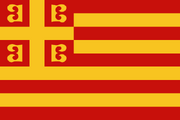
The Kormenian Flag
The first flag is the denomined as "the Kormenian Flag" .The significance of this flag is where each line represents a golden ethnicity ruled by a central government (represented by the cross tetragramica, called after as the Kormenian Cross), implying that every human person is subject not only the emperor, but of God himself, but that idea went nowhere in official terms, is became popular among the people and nobles of influence connoted as the Komnenos and Batatzes, laid down the exact pattern; nine alternate-colored stripes with the tetragramic cross on a red field in the canton.
Kalapotharakos Flag[]
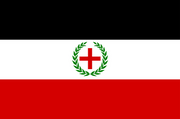
Flag proposed by Sofoklis for his envisioned Ruthene nation.
Exist another flag known as the unofficial flag of the Empire, the "Protoepanasi" flag, this flag was used during the first revolutionary uprising by Michael Auronopoulos and his troops during the Battle of Koronia, the flag himself was idea of Sofoklis Kalapotharakos, Michael mentor and one of the ideas of the revolution.
Enosis Flag[]
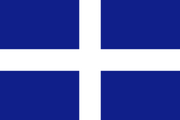
The Revolutionary flag of the Enosis, creation of Athanasios Georgadis
The flag used during the second uprising or the Enosis was designed by Athanasios Georgiadis during the siege of Kalemata, since then was used by the revolutionaries as the official flag of the revolution, the flag is blue with a white cross in the center, the inspiration is unknown but some historians have the ideas of inspiration of Doukas dynasty and other Selloi notable families
Other Flags[]
Thracia flag[]
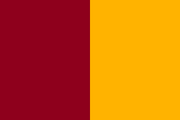
Flag of Principate of Thracia
The origins of today's national Thracia flag with the two colors and its red and yellow vertical. The shade of red is quite dark, the yellow tends toward gold, the origin is for the Mauryan legacy: the yellow or gold is the colors of the Lion of Mauria, the representative of the Mauryan people and the gold is the Carantian origin, the red is the dark red is the color of Ruthenia in various representative protocols, the flag represent of the union of the two people.
Mount Agios flag[]
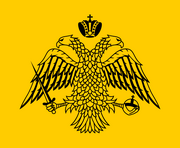
Flag of the Orthodox Church
The Mount Agios flag is recognized as the "flag of the church," is a simple flag up yellow with the double headed eagle embedded in the center, is considered the official flag for all presentations of the church in the empire, the double headed eagle is presented as an imperial symbol giving the meaning that "the state and the church are united under a common goal," said target is variable to the will of basileus, who is responsible to god alone be the patriarch his "messenger", the flag is considered the oficial flag of the Ecumenical Patriarchate of Auronopolis and the flag of Mount Agios
Respect for the flag[]
The state flag can be hoisted so that they touch the ground, nor be used as rests, tablecloths, carpets or curtains, nor to cover vehicles or other objects, nor to attire speaker platforms or tables, except as table flags. They must not be used if damaged or otherwise look unsuitable for use.
The flag is not flown in bad weather conditions. Also, it is flown only in daylight, unless it is illuminated.
If the flag is flown vertically on tables or otherwise, its top field is on the left side of the viewer. If it is flown vertically across a street or square, its top field should be on the northern side if the street has east-west orientation, and eastern side if it has north-south orientation or on a circular square.
Correct Display[]
The law defines how the flag of Ruthenia is displayed along with other flags, making no difference between state flags and other kinds of flags.
If the flag is hoisted with another flag, it is always on the viewer's left, except during an official visit of a representative of another country or an international organization, when the flag of the visitor is it is on the viewer's left. If the flag is hoisted with another on crossed staffs, its staff must be the front one.
- If the flag of Ruthenia is hoisted along with two flags, it must be in the middle.
- If the flag is flown with multiple flags,
- If the flags are flown in a circle, it must be in the center of the circle, clearly visible;
- If the flags are flown in a semicircle, it must be in its vertex;
- If the flags are flown in a column, it must be in the front of the column;
- If the flags are flown in a row, it must be in the first place, that is, on the viewer's left;
- If the flags are flown in a group, it must be in the front of the group.

